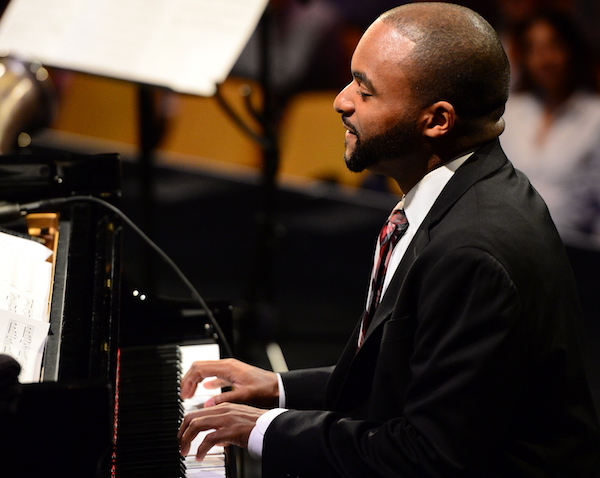Oct 28, 2025 10:47 AM
In Memoriam: Jack DeJohnette, 1942–2025
Jack DeJohnette, a bold and resourceful drummer and NEA Jazz Master who forged a unique vocabulary on the kit over his…

Sullivan Fortner performs at Jazz at Lincoln Center in New York as part of JALC’s Opening Night on Sept. 14.
(Photo: Frank Stewart/Jazz at Lincoln Center)“The Fantastic Mr. Jelly Lord,” the all-Jelly Roll Morton concert that opened the 2017 season of the Jazz at Lincoln Center Orchestra, revealed the continued relevance of the great New Orleans maestro and was as good a case as any for Wynton Marsalis’ credo that “all jazz is modern.”
The piano chair for the evening featured a rotating cast including three great young pianists (Aaron Diehl, Sullivan Fortner and the JLCO’s own Dan Nimmer) and a pair of even younger, highly promising Juilliard student pianists (Micah Thomas from Ohio and Joel Wenhardt from California). Playing a mix of original Morton charts and new interpretations arranged by JLCO members (and one by former member Wycliffe Gordon), the music sounded fresh and vivid—nothing like a dusty relic of another time.
Before a full house at Jazz at Lincoln Center’s plush, jewel-box-like Rose Theater, the 15 members entered from stage-right, looking sharp in matching dark gray suits (Brooks Brothers is a JALC sponsor), striped ties and brown shoes. Marsalis, in his customary role as host and explainer-in-chief, began the evening in self-deprecating fashion: “Tonight we have a lot of music to play, so you won’t get your customary, long-winded speeches about nothing,” he said. Before he introduced the band’s first number, however, he did note that, regardless of the truth of Morton’s claims that he “invented jazz,” he was “the first intellectual of jazz.”
A classically trained pianist, Morton was, by his own account, kicked out of his family’s home for playing jazz in New Orleans’ red-light district. Among his many distinctions, he was the first to show that this “unruly” music could be properly notated. His piano playing style was original and highly influential, and his striking compositions and arrangements for his Red Hot Peppers advanced the New Orleans jazz of his time with complex structures derived from ragtime and the European tradition.
The program combined familiar Morton standards like “King Porter Stomp” and “Jelly Roll Blues” with lesser-known works like the slow drag “Deep Creek” and “Burnin’ The Iceberg.”
The orchestra’s approach to these early jazz masterpieces was to reveal both the modern in Morton’s original arrangements and the roots that nourish the JLCO’s contemporary big band arranging. That philosophy was apparent in the first piano solo, by Diehl, on a fine update of “Little Lawrence” by clarinetist Victor Goines. Diehl’s advanced harmonies and rhythmic displacements were particularly noteworthy. Nimmer followed with an expressive, blues-drenched turn on “Mr. Joe,” (possibly named after New Orleans bandleader Joe “King” Oliver).
“Sidewalk Blues,” brilliantly arranged by alto saxophonist Sherman Irby, was a showstopper, beginning, as in the original, with the brass section simulating traffic noises and a near-accident, and an altercation that featured a comical dialogue between trombonists Vincent Gardner and Chris Crenshaw. In a confident piano solo, Fortner, a product of New Orleans, seemed to channel the ancestors. His two-fisted virtuosity with a Southern drawl got the audience cheering. He also contributed singular solos to a Marsalis arrangement of “King Porter Stomp,” a Goines arrangement of “Burnin’ The Iceberg” and a version of “The Crave” arranged by bassist Carlos Henriquez. The latter developed the tune’s tango-like rhythms into a fast-paced, Latin expansion of Morton’s composition. The “Latin tinge” became a high-energy salsa explosion.
Diehl’s impressive piano solo on “The Pearls,” although based in early New Orleans rhythms, included passages of post-bop rhythmic complexity and harmonic ambiguity. The two Juilliard students had multiple opportunities to shine. Thomas was featured on “Grandpa’s Spells” and the famously difficult “Fingerbreaker,” both of which he executed admirably. And Wenhardt, whom Marsalis described as “a poet,” offered a leisurely, exquisitely timed solo on the slow blues “Deep Creek” and another fascinating turn on the complex, exotic “Ganjam,” from Morton’s late period.
In the JLCO’s hands, Morton’s music sounded vital, un-dated and full of humor and invention. Early in the first set, Fortner told an anecdote: A few years ago, when he had only recently been introduced to Marsalis, he found himself sitting in the trumpeter’s living room. “We were drinking some expensive Scotch. And I told him I was having some problems with my music. He told me, ‘You need to listen to Jelly Roll Morton.’”
Good advice for jazz players and fans alike. DB

Jack DeJohnette boasted a musical resume that was as long as it was fearsome.
Oct 28, 2025 10:47 AM
Jack DeJohnette, a bold and resourceful drummer and NEA Jazz Master who forged a unique vocabulary on the kit over his…

D’Angelo achieved commercial and critical success experimenting with a fusion of jazz, funk, soul, R&B and hip-hop.
Oct 14, 2025 1:47 PM
D’Angelo, a Grammy-winning R&B and neo-soul singer, guitarist and pianist who exerted a profound influence on 21st…

To see the complete list of nominations for the 2026 Grammy Awards, go to grammy.com.
Nov 11, 2025 12:35 PM
The nominations for the 2026 Grammy Awards are in, with plenty to smile about for the worlds of jazz, blues and beyond.…

Flea has returned to his first instrument — the trumpet — and assembled a dream band of jazz musicians to record a new album.
Dec 2, 2025 2:01 AM
After a nearly five-decade career as one of his generation’s defining rock bassists, Flea has returned to his first…

Drummond was cherished by generations of mainstream jazz listeners and bandleaders for his authoritative tonal presence, a defining quality of his style most apparent when he played his instrument unamplified.
Nov 4, 2025 11:39 AM
Ray Drummond, a first-call bassist who appeared on hundreds of albums as a sideman for some of the top names in jazz…





